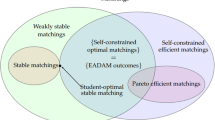Abstract
I model a teacher transfer program in South Korea as a matching-with-contracts problem. The current (non-centralized) system allows a teacher wishing to make an inter-state transfer to submit, at most, one application and will approve only a one-to-one exchange. Consequently, not only is this current system unstable and inefficient, but it also does not adequately reflect the teachers’ preferences. In contrast, the centralized mechanism I propose fully represents teachers’ preferences and is less wasteful. One key requirement of a teacher transfer program is that it must protect the rights of currently existing teachers who wish to transfer from their current positions, perhaps to satisfy familial needs, for only a short period of time. However, as I demonstrate, no stable mechanism exists that guarantee protection for the rights of such teachers to the positions they currently occupy. To solve this problem, I introduce a novel concept called a claim contract. A claim contract, in a matching-with-contracts model, protects current teachers by removing contracts that do not match the specified duration set by these teachers from the set of potential matches. In this paper, I propose a new mechanism, based on a claim contract, that is strategy-proof and approximates stable matching.
Similar content being viewed by others
Notes
South Korea consists of seventeen states, which contain provinces and metropolitan cities. In this study, each independent administrative region is defined as a “state.”
For elementary education, applicants who graduated with a degree in elementary education in the state in which they are undergoing screening receive additional points on their exams.
Even though it is not common, new schools in recently developed cities can create new positions as well.
For example, if a teacher has less than three years of experience or has a criminal record, she may not be eligible for a transfer.
This is based on “Inter State Exchange Plan” by Sejong City Office of Education, 2019. Other states have similar structures.
Korea has 6 degrees of disabled status, with 1 being the most severe.
In a separate work, Jinyong Jeong (2020) studied this problem in the context of an efficiency notion, analyzing the problem as a special case of housing exchange problem.
A permanent transfer should be understood as a permanent move to a given state, not to a given position. The current practice is that the positions rotate every three to five years within the state. However, this rotation system is beyond the scope of this paper.
This restriction reflects the current system under which new teachers can only be assigned in the state in which he or she took the teachers examination.
In a general setting, it can be referred to as protecting property rights.
As a result, the claim contract will be chosen, and the contract held by \(s^{i_{Ek}}\) may be rejected in this step, if it is a long-term contract.
The removed one is not “rejected” yet, and so it can be used in a later offer.
This happens when there is a teacher who finds both short-term and long-term contracts acceptable, and at least one short-term contract is preferred to some long-term contracts. Given that the main motivation for the transfer is family needs, teachers exhibiting such a preference will not be common.
If a short-term contract is rejected, then it is rejected because of another short-term contract, so that there is no way to manipulate it.
The term does not need to be a \(t^{+}\).
It is not yet known whether the cumulative offer with claim contract mechanism is the least wasteful mechanism among all the strategy-proof and existing-teacher-protecting mechanisms.
They are not stable with respect to the preferences and priorities. Note that stability is not compatible with protecting teachers.
References
Abdulkadiroğlu A, Sönmez T (1999) House allocation with existing tenants. J Econ Theory 88:233–260
Abdulkadiroğlu A, Sönmez T (2003) School choice: a mechanism design approach. Am Econ Rev 93(3):729–747
Abdulkadiroğlu A, Sönmez T (2013) Matching markets: theory and practice. Adv Econ Econom 1:3–47
Aygün O, Sönmez T (2013a) The importance of irrelevance of rejected contracts in matching under weakened substitutes conditions. Working paper
Aygün O, Sönmez T (2013b) Matching with contracts: comment. Am Econ Rev 103:201–213
Barbieri G, Rossetti C, Sestito P (2011) The determinants of teacher mobility: Evidence using italian teachers’ transfer applications. Econ Educ Rev 30(6):1430–1444 (special issue: Economic Returns to Education)
Combe J, Tercieux O, Terrier C (2018) The design of teacher assignment: theory and evidence, Discussion paper, Mimeo
Dur U, Kesten O (2019) Sequential versus simultaneous assignment systems and two applications. Econ Theory 68:251
Ergin H, Sönmez T (2006) Games of school choice under the Boston mechanism. J Public Econ 90:215–237
Gale D, Shapley L (1962) College admissions and the stability of marriage. Am Math Mon 69(1):9–15
Guillen P, Kesten O (2012) Matching markets with mixed ownership: the case for a real-life assignment mechanism. Int Econ Rev 53:1027–1046
Hatfield JW, Kojima F (2010) Substitutes and stability for matching with contracts. J Econ Theory 145:1704–1723
Hatfield JW, Kominers SD (2016) Hidden Substitutes. Working Paper
Hatfield JW, Milgrom P (2005) Matching with contracts. Am Econ Rev 95(4):913–935
Jeong J (2020) Teachers exchange in Korea. Working paper
Kelso AS, Crawford VP (1982) Job matching, coalition formation, and gross substitutes. Econometrica 50(6):1483–1504
Kominers SD, Sönmez T (2016) Matching with slot-specific priorities: theory. Theor Econ 11:683–710
Pereyra JS (2013) A dynamic school choice model. Games Econ Behav 80:100–114
Roth A, Sönmez T, Ünver U (2004) Kidney exchange. Q J Econ 119:457–488
Sönmez T (2013) Bidding for army career specialties: improving the ROTC branching mechanism. J Polit Econ 121(1):186–219
Sönmez T (2014) Cadet-branch matching. ACM SIGecom Exchanges 13:50–57
Sönmez T, Switzer T (2013) Matching with (branch-of-choice) contracts at the united states military academy. Econometrica 81:451–488
Terrier C (2014) Matching practices for secondary public school teachers–France. MiP Country Profile 20
Author information
Authors and Affiliations
Corresponding author
Additional information
Publisher's Note
Springer Nature remains neutral with regard to jurisdictional claims in published maps and institutional affiliations.
Rights and permissions
About this article
Cite this article
Jeong, J. Matching with property rights: an application to Korean teacher transfer program. Rev Econ Design 25, 139–156 (2021). https://doi.org/10.1007/s10058-021-00245-8
Received:
Accepted:
Published:
Issue Date:
DOI: https://doi.org/10.1007/s10058-021-00245-8




